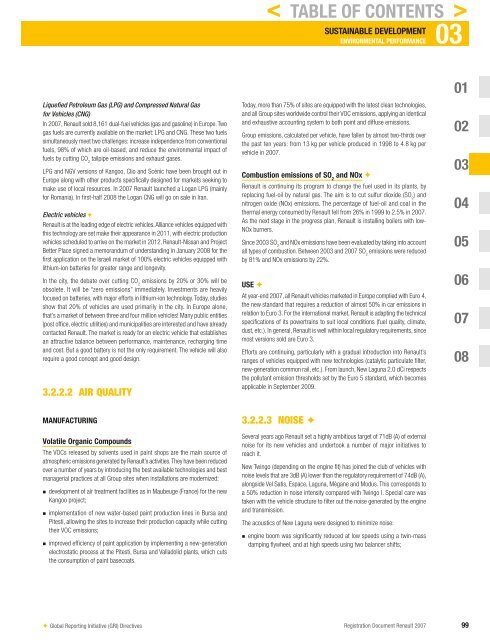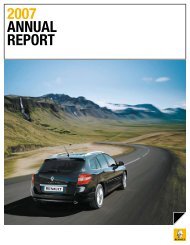2007 Interactive Registration Document - Renault
2007 Interactive Registration Document - Renault
2007 Interactive Registration Document - Renault
You also want an ePaper? Increase the reach of your titles
YUMPU automatically turns print PDFs into web optimized ePapers that Google loves.
Liquefied Petroleum Gas (LPG) and Compressed Natural Gas<br />
for Vehicles (CNG)<br />
In <strong>2007</strong>, <strong>Renault</strong> sold 8,161 dual-fuel vehicles (gas and gasoline) in Europe. Two<br />
gas fuels are currently available on the market: LPG and CNG. These two fuels<br />
simultaneously meet two challenges: increase independence from conventional<br />
fuels, 98% of which are oil-based, and reduce the environmental impact of<br />
fuels by cutting CO 2 tailpipe emissions and exhaust gases.<br />
LPG and NGV versions of Kangoo, Clio and Scénic have been brought out in<br />
Europe along with other products specifi cally designed for markets seeking to<br />
make use of local resources. In <strong>2007</strong> <strong>Renault</strong> launched a Logan LPG (mainly<br />
for Romania). In fi rst-half 2008 the Logan CNG will go on sale in Iran.<br />
Electric vehicles ✦<br />
<strong>Renault</strong> is at the leading edge of electric vehicles. Alliance vehicles equipped with<br />
this technology are set make their appearance in 2011, with electric production<br />
vehicles scheduled to arrive on the market in 2012. <strong>Renault</strong>-Nissan and Project<br />
Better Place signed a memorandum of understanding in January 2008 for the<br />
fi rst application on the Israeli market of 100% electric vehicles equipped with<br />
lithium-ion batteries for greater range and longevity.<br />
In the city, the debate over cutting CO 2 emissions by 20% or 30% will be<br />
obsolete. It will be “zero emissions” immediately. Investments are heavily<br />
focused on batteries, with major efforts in lithium-ion technology. Today, studies<br />
show that 20% of vehicles are used primarily in the city. In Europe alone,<br />
that’s a market of between three and four million vehicles! Many public entities<br />
(post offi ce, electric utilities) and municipalities are interested and have already<br />
contacted <strong>Renault</strong>. The market is ready for an electric vehicle that establishes<br />
an attractive balance between performance, maintenance, recharging time<br />
and cost. But a good battery is not the only requirement. The vehicle will also<br />
require a good concept and good design.<br />
3.2.2.2 AIR QUALITY<br />
MANUFACTURING<br />
Volatile Organic Compounds<br />
The VOCs released by solvents used in paint shops are the main source of<br />
atmospheric emissions generated by <strong>Renault</strong>’s activities. They have been reduced<br />
over a number of years by introducing the best available technologies and best<br />
managerial practices at all Group sites when installations are modernized:<br />
n<br />
n<br />
n<br />
development of air treatment facilities as in Maubeuge (France) for the new<br />
Kangoo project;<br />
implementation of new water-based paint production lines in Bursa and<br />
Pitesti, allowing the sites to increase their production capacity while cutting<br />
their VOC emissions;<br />
improved effi ciency of paint application by implementing a new-generation<br />
electrostatic process at the Pitesti, Bursa and Valladolid plants, which cuts<br />
the consumption of paint basecoats.<br />
✦ Global Reporting Initiative (GRI) Directives<br />
< TABLE OF CONTENTS ><br />
SUSTAINABLE DEVELOPMENT 03<br />
ENVIRONMENTAL PERFORMANCE<br />
Today, more than 75% of sites are equipped with the latest clean technologies,<br />
and all Group sites worldwide control their VOC emissions, applying an identical<br />
and exhaustive accounting system to both point and diffuse emissions.<br />
Group emissions, calculated per vehicle, have fallen by almost two-thirds over<br />
the past ten years: from 13 kg per vehicle produced in 1998 to 4.8 kg per<br />
vehicle in <strong>2007</strong>.<br />
Combustion emissions of SO 2 and NOx ✦<br />
<strong>Renault</strong> is continuing its program to change the fuel used in its plants, by<br />
replacing fuel-oil by natural gas. The aim is to cut sulfur dioxide (SO 2 ) and<br />
nitrogen oxide (NOx) emissions. The percentage of fuel-oil and coal in the<br />
thermal energy consumed by <strong>Renault</strong> fell from 26% in 1999 to 2.5% in <strong>2007</strong>.<br />
As the next stage in the progress plan, <strong>Renault</strong> is installing boilers with low-<br />
NOx burners.<br />
Since 2003 SO 2 and NOx emissions have been evaluated by taking into account<br />
all types of combustion. Between 2003 and <strong>2007</strong> SO 2 emissions were reduced<br />
by 81% and NOx emissions by 22%.<br />
USE ✦<br />
At year-end <strong>2007</strong>, all <strong>Renault</strong> vehicles marketed in Europe complied with Euro 4,<br />
the new standard that requires a reduction of almost 50% in car emissions in<br />
relation to Euro 3. For the international market, <strong>Renault</strong> is adapting the technical<br />
specifi cations of its powertrains to suit local conditions (fuel quality, climate,<br />
dust, etc.). In general, <strong>Renault</strong> is well within local regulatory requirements, since<br />
most versions sold are Euro 3.<br />
Efforts are continuing, particularly with a gradual introduction into <strong>Renault</strong>’s<br />
ranges of vehicles equipped with new technologies (catalytic particulate fi lter,<br />
new-generation common rail, etc.). From launch, New Laguna 2.0 dCi respects<br />
the pollutant emission thresholds set by the Euro 5 standard, which becomes<br />
applicable in September 2009.<br />
3.2.2.3 NOISE ✦<br />
Several years ago <strong>Renault</strong> set a highly ambitious target of 71dB (A) of external<br />
noise for its new vehicles and undertook a number of major initiatives to<br />
reach it.<br />
New Twingo (depending on the engine fi t) has joined the club of vehicles with<br />
noise levels that are 3dB (A) lower than the regulatory requirement of 74dB (A),<br />
alongside Vel Satis, Espace, Laguna, Mégane and Modus. This corresponds to<br />
a 50% reduction in noise intensity compared with Twingo I. Special care was<br />
taken with the vehicle structure to fi lter out the noise generated by the engine<br />
and transmission.<br />
The acoustics of New Laguna were designed to minimize noise:<br />
n engine boom was signifi cantly reduced at low speeds using a twin-mass<br />
damping fl ywheel, and at high speeds using two balancer shifts;<br />
01<br />
02<br />
03<br />
04<br />
05<br />
06<br />
07<br />
08<br />
<strong>Registration</strong> <strong>Document</strong> <strong>Renault</strong> <strong>2007</strong> 99




